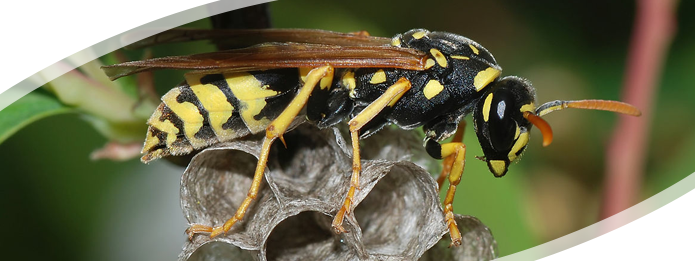Taking a look at the do’s and don’ts when it comes to wasps

There is something about that tiny waist, the dangling legs, and of course the formidable stinger of a wasp, that puts people on edge. Spheksophobia is an irrational fear of these flying insects, but even those without the condition don’t like having them around. The simplest solution for wasp control is to call in a professional. In the meantime, however, here are some do’s and don’t for dealing with wasps on your Niagara property.
Keeping Wasps Away
Cohabiting with wasps can be a tricky situation. The following do’s and don’t can help you keep the peace with these volatile residents:
- Don’t try to deter wasps with fabric softener sheets or a penny in a plastic bag filled with water. These home remedies are not effective repellents.
- Don’t waste money hanging an artificial hive. Although a colony will not build in the same spot, nothing will stop them from constructing a home right next door.
- Don’t rely on wasp traps. They may kill a few, but will not eliminate an entire colony.
- Do keep calm. Scientific studies show wasps can recognize individual faces and become accustomed to non-threatening humans in their environment.
- Do cover fruit and sugary drinks when outdoors. Wasps are attracted to these foods, and you may unintentionally be stung in the mouth when taking a drink.
- Do check for wasps on the underside of shrubs before doing yard work. Shaking a branch with a nest will cause them to swarm in defense of their colony. Wasps will bite or sting to preserve their territory.
Removing a Nest
A wasp nest can be an unsettling landmark on your property. Here are some do’s and don’t for removing it:
- Don’t remove a nest at night, thinking the wasps will stay asleep. They do become inactive after dark but will wake up if they feel threatened.
- Don’t burn a paper wasp hive. Burning a hanging nest can catch surrounding structures on fire.
- Don’t flood an underground nest. Dousing it with water will drown only a portion of the wasps, and the survivors will rebuild nearby.
- Do remove old nests in winter. All but the queen die during the fall, so a nest that looks abandoned probably is.
- Do stay calm. Swatting makes wasps feel threatened and can initiate an attack.
- Do get professional assistance. Help is just a phone call away.
Being Attacked
Being attacked by a swarm of insects can be a terrifying experience. Remember these do’s and don’ts in the unfortunate instance that wasps chase or sting you.
- Don’t play dead. Wasps will continue to sting repeatedly, regardless of whether you are moving.
- Don’t put a copper penny on the sting. Instead, try a plastic venom extractor or drawing salve, followed by hydrocortisone cream to minimize itching.
- Don’t assume you are allergic. Bee and wasp venom are very different, so someone who experiences severe reactions to bees may not have the same reaction to wasp stings.
- Do run fast, far, and in a straight line. It’s true that wasps fly faster than humans run, but they will give up after 100 meters, and zigzagging only slows you down.
- Do cover your face and neck. Wasps aim for the head when attacking, and stings in this region are particularly painful.
- Do remove stingers from your skin. Wasps can sting multiple times, but a stinger can lodge in your skin if you press it against your body while smacking the wasp.
Don’t risk getting stung. When in doubt, the best thing to do is to call Truly Nolen in Niagara. We are happy to determine what species of stinging insect is nesting on your property and to use our professional expertise to remove them safely.